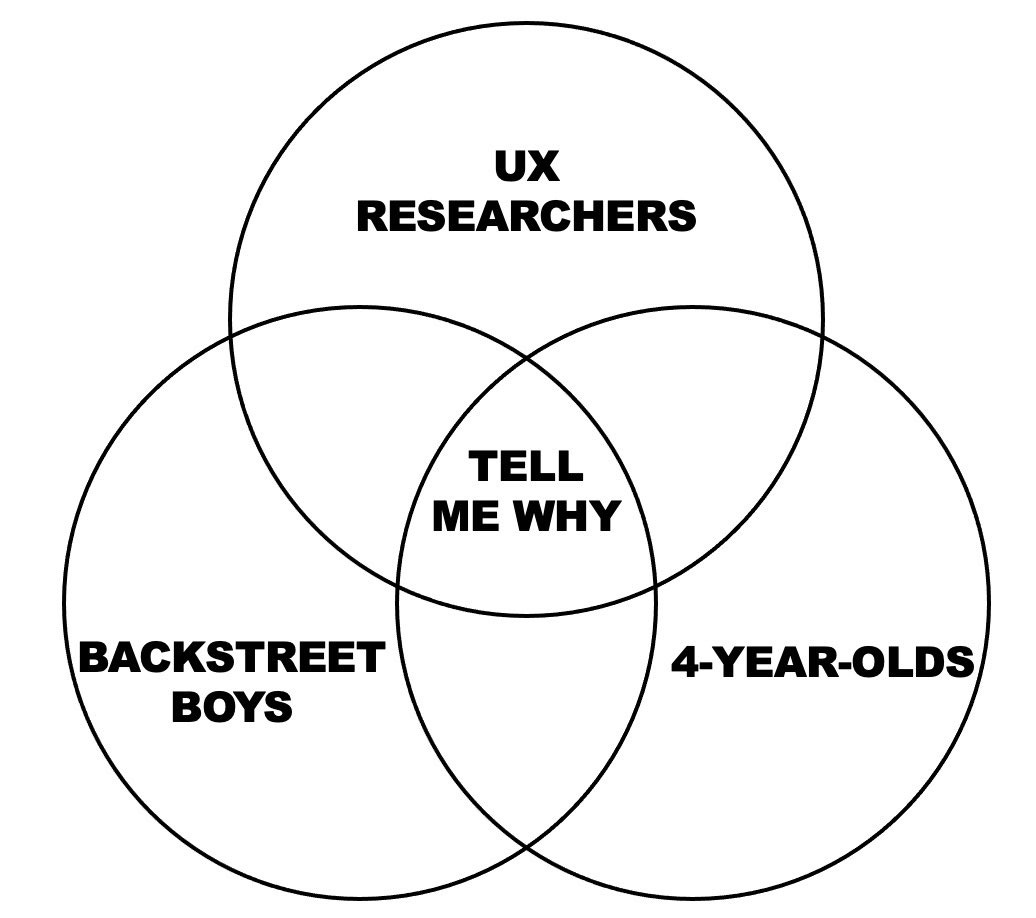Beyond the Surface: The Double-Edged Sword of Asking "Why?" in UX
Uncover the strengths and weaknesses of probing users for reasons behind their actions and preferences.

In user experience (UX) research, asking users "Why?" is a fundamental practice aimed at uncovering the motivations behind their behaviours and preferences. On the surface, this approach seems straightforward: by understanding the reasons users provide, we can design products that better meet their needs. However, psychological research suggests that the effectiveness of "Why?" questions is more complex than it appears.
This article explores both the power and limitations of asking "Why?" in UX research, providing strategies to maximise its benefits while mitigating potential pitfalls.
The Power of "Why" in UX Research
The power of "Why?" questions lies in their apparent simplicity and depth. Most of us start our lives as little scientists and spend a considerable amount of time asking why in order to understand and make sense of the world. Researchers, by repeatedly asking why, aim to see beyond surface-level responses to reveal core motivations and mental models. This approach is rooted in the belief that users have access to their own decision-making processes and can articulate them when prompted.
Uncovering root causes: The "Five Whys" technique is a powerful tool for identifying underlying issues in UX problems. It was developed and fine-tuned within the Toyota Motor Corporation as a critical component of its problem-solving training. By repeatedly asking "Why?", we can drill down to the root cause of user behaviours or pain points, often revealing insights that aren't immediately apparent.
Predicting user behaviour: The Theory of Planned Behaviour (Ajzen, 1991) suggests that understanding the reasons behind user intentions leads to better predictions of behaviour. In UX research, insights gained from "Why?" questions can inform design strategies that align more closely with user intentions and motivations.
Understanding emotional drivers: Desmet & Hekkert (2007) highlight the crucial role of emotions in user experience. "Why?" questions can be instrumental in uncovering these emotional drivers, leading to more empathetic and effective designs.
Uncovering latent needs: In UX, "Why?" questions can be particularly effective in uncovering user needs and goals that may not be immediately apparent. They can help us move beyond what users say they want to understand the underlying motivations driving those desires.
Limitations and Pitfalls
However, the efficacy of "Why?" questions is not without its limitations. A growing body of research in cognitive psychology and behavioural economics has highlighted several key issues that we need to be mindful of:
Lack of introspective access and post-hoc rationalisation
Nisbett and Wilson (1977) argued that people often lack introspective access to their cognitive processes. This means that when asked "Why?", participants may not actually know the true reasons for their behaviours or preferences. Neuroimaging studies have also provided compelling evidence that individuals often lack introspective access to their own cognitive processes. For example, an influential study by Soon et al. (2008) used functional magnetic resonance imaging (fMRI) to investigate the timing of conscious decision-making. Participants were asked to press one of two buttons at their leisure while noting the moment they became aware of their intention to press a specific button. The results showed that patterns of brain activity in the frontopolar cortex and precuneus regions predicted the participants' choices up to 7 seconds before they reported conscious awareness of their decision. This suggests that unconscious neural processes determine our decisions well before we become consciously aware of them. In UX research, this implies that when users are asked "Why did you choose this option?" they may not have conscious access to the true underlying reasons. Their explanations might be post-hoc rationalisations rather than reflections of their actual decision-making processes.
Johansson et al. (2005) demonstrated through their "choice blindness" experiments that people can confidently provide reasons for choices they didn't actually make. In their study, participants were shown pairs of images (such as faces or landscapes) and asked to choose their preferred one. Unbeknownst to them, the researchers used sleight-of-hand techniques to swap the images after the selection.
When asked to explain their choices, many participants did not notice the switch and provided detailed justifications for the image they had not originally chosen. This phenomenon demonstrates that people can confidently generate explanations for choices they did not make, highlighting the prevalence of confabulation and post-hoc rationalisation. This suggests that when pressed for explanations, individuals may engage in post-hoc rationalisation, inventing plausible but potentially inaccurate reasons for their actions. In UX research, this suggests that users might provide plausible but inaccurate reasons when explaining their preferences or behaviours. For instance, a user might attribute their preference for a website design to its colour scheme, even if their choice was influenced by other factors like loading speed or familiarity.
Cognitive dissonance
Festinger's Cognitive Dissonance Theory (1957) explains how users may rationalise their answers to align with their self-perception. This can lead to justifications that don't necessarily reflect true motivations. For example, consider a user who claims they value privacy highly but continues to use apps that collect personal data. When asked "Why?", the user justifies their behaviour by downplaying privacy concerns, aligning their answers with their actions to reduce internal conflict.
Cultural and contextual influences
Cultural factors have also been show to influence human-computer interaction. In particular, cultural factors can influence cognitive processes and communication styles. Markus and Kitayama (1991) introduced the concepts of independent and interdependent self-construals, explaining how Western cultures tend to emphasise individuality (independent self), while Eastern cultures focus on social harmony and relationships (interdependent self).
Additionally, Nisbett and Masuda (2003) found that East Asians are more likely to attend to contextual information and relationships between objects, whereas Westerners focus on salient objects independently of their context. These differences affect not only perception but also communication patterns.
In the context of UX research, these cultural differences can impact how users respond to "Why?" questions. For example, users from cultures that value social harmony may avoid giving negative feedback to prevent offending the researcher. For instance, in a usability test, a participant from a high-context culture might downplay issues with a product to maintain a positive interaction. Recognising these cultural nuances is essential for accurate data interpretation and may require adapting research methods to elicit more genuine responses.
Social desirability bias
Social desirability bias occurs when participants respond in a manner they believe is socially acceptable rather than being truthful. Fisher (1993) examined how this bias affects self-reported data, especially in areas involving ethical behaviours or sensitive topics.
Moreover, Krumpal (2013) conducted a literature review and found that social desirability bias leads to significant underreporting of undesirable behaviours and over-reporting of desirable ones. This distortion can severely impact the validity of research data.
In UX social desirability bias can lead users to overstate their positive interactions with a product or underreport difficulties. For example, when asked "Why do you use our app daily?" users might exaggerate their usage frequency to appear more engaged or technologically savvy.
Cognitive load and participant fatigue
Krosnick (1991) discussed how cognitive fatigue can lead to "satisficing" in surveys — providing merely satisfactory rather than optimal responses. During an interview or a survey repeatedly asking "Why?" can be mentally taxing for the users, potentially leading to superficial or unreliable answers as the interview progresses.
Making the Most Out of "Why" Questions
Given these challenges, how can we leverage the power of "Why?" while mitigating its pitfalls? By no means am I suggesting not asking why questions. However, there are a few strategies we can employ:
Triangulation: Triangulation is the practice of using multiple sources of data or multiple approaches to analysing data, to enhance the credibility of a research study. This is something we have discussed in previous posts and can also help in this instance. By combining "Why?" questions with other methods like observations, surveys, and analytics, researchers can cross-verify insights and build a more comprehensive understanding. Comparing what users do versus what users think can provide us a more holistic understanding of them.
Behavioural Observation: Observing what users do, rather than just asking them why they do it, can provide crucial insights.
Implicit Measures: Techniques like the Implicit Association Test can reveal attitudes and preferences that users may not be consciously aware of or willing to report. You can read more about this in my article on implicit measures in UX.
Awareness of Cognitive Biases: Being aware of the cognitive biases affecting user (as well as researchers!) can also be a good starting point. Understanding how they can affect our research, allows us to develop specific strategies to reduce their impact on user responses.
Conclusion
The question "Why?" remains a powerful tool in our research toolbox, but its application requires nuance and an awareness of its limitations. By understanding the potential for post-hoc rationalisation, social desirability bias, and the limits of introspection, we can design more effective inquiry strategies.
A balanced approach involves:
Using "Why?" questions judiciously, complemented by other techniques
Triangulating data from multiple sources to validate insights
Remaining sceptical of surface-level explanations and diving deeper when necessary
Being aware of cultural and contextual influences on user responses
Employing a mix of direct and indirect methods to uncover user motivations
As our understanding of human cognition and decision-making evolves, so too must our research methodologies. The key lies not in abandoning "Why?" questions, but in using them more effectively as part of a comprehensive, evidence-based approach to understanding user behaviour and motivations.
Note: Thanks to everyone who’s been reading and supporting this substack. You might have noticed that I haven’t been posting weekly lately. I’m currently experiencing some health issues (autoimmune conditions are no fun) but, hopefully, I’ll be back to regular posting soon. Thanks for understanding!





Great article, I agree you should observe behaviour, rather than ask people why. I think the culture aspect of computer used is often overlooked and I'm glad you mentioned that.